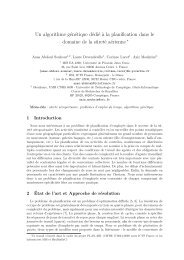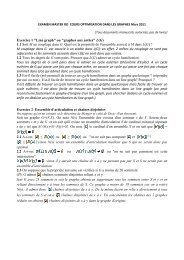Sensitivity analysis for the outages of nuclear power plants - SADCO ...
Sensitivity analysis for the outages of nuclear power plants - SADCO ...
Sensitivity analysis for the outages of nuclear power plants - SADCO ...
You also want an ePaper? Increase the reach of your titles
YUMPU automatically turns print PDFs into web optimized ePapers that Google loves.
Introduction Study <strong>of</strong> <strong>the</strong> reference problem <strong>Sensitivity</strong> <strong>analysis</strong><br />
<strong>Sensitivity</strong> <strong>analysis</strong> <strong>for</strong> <strong>the</strong> <strong>outages</strong> <strong>of</strong> <strong>nuclear</strong><br />
<strong>power</strong> <strong>plants</strong><br />
<strong>SADCO</strong>: 2 nd Industrial Workshop<br />
Laurent Pfeiffer ∗ , Frédéric Bonnans ∗ and Kengy Barty †<br />
∗ INRIA Saclay and CMAP, Ecole Polytechnique, † EDF R&D<br />
February 2, 2012
Introduction Study <strong>of</strong> <strong>the</strong> reference problem <strong>Sensitivity</strong> <strong>analysis</strong><br />
Introduction<br />
Study <strong>of</strong> a two-level problem:<br />
optimization <strong>of</strong> <strong>the</strong> dates <strong>of</strong> <strong>the</strong> <strong>outages</strong> <strong>of</strong> <strong>nuclear</strong> <strong>power</strong><br />
<strong>plants</strong><br />
optimization <strong>of</strong> <strong>the</strong> production <strong>of</strong> electricity.<br />
Our approach:<br />
1 fix a schedule τ<br />
2 optimize <strong>the</strong> production <strong>of</strong> electricity: V (τ)<br />
3 per<strong>for</strong>m a sensitivity <strong>analysis</strong>: compute V ′ (τ)<br />
4 improve <strong>the</strong> schedule.
Introduction Study <strong>of</strong> <strong>the</strong> reference problem <strong>Sensitivity</strong> <strong>analysis</strong><br />
Introduction<br />
Study <strong>of</strong> a two-level problem:<br />
optimization <strong>of</strong> <strong>the</strong> dates <strong>of</strong> <strong>the</strong> <strong>outages</strong> <strong>of</strong> <strong>nuclear</strong> <strong>power</strong><br />
<strong>plants</strong><br />
optimization <strong>of</strong> <strong>the</strong> production <strong>of</strong> electricity.<br />
Our approach:<br />
1 fix a schedule τ<br />
2 optimize <strong>the</strong> production <strong>of</strong> electricity: V (τ)<br />
3 per<strong>for</strong>m a sensitivity <strong>analysis</strong>: compute V ′ (τ)<br />
4 improve <strong>the</strong> schedule.
Introduction Study <strong>of</strong> <strong>the</strong> reference problem <strong>Sensitivity</strong> <strong>analysis</strong><br />
1 Study <strong>of</strong> <strong>the</strong> reference problem<br />
Model<br />
Pontryagin’s principle<br />
Structure <strong>of</strong> optimal controls<br />
2 <strong>Sensitivity</strong> <strong>analysis</strong><br />
Abstract <strong>the</strong>orem<br />
Toy example<br />
Application to <strong>the</strong> <strong>outages</strong>
Introduction Study <strong>of</strong> <strong>the</strong> reference problem <strong>Sensitivity</strong> <strong>analysis</strong><br />
1 Study <strong>of</strong> <strong>the</strong> reference problem<br />
Model<br />
Pontryagin’s principle<br />
Structure <strong>of</strong> optimal controls<br />
2 <strong>Sensitivity</strong> <strong>analysis</strong><br />
Abstract <strong>the</strong>orem<br />
Toy example<br />
Application to <strong>the</strong> <strong>outages</strong>
Introduction Study <strong>of</strong> <strong>the</strong> reference problem <strong>Sensitivity</strong> <strong>analysis</strong><br />
Model<br />
General notations:<br />
S <strong>the</strong> set <strong>of</strong> <strong>plants</strong>, <strong>of</strong> cardinal n<br />
T <strong>the</strong> horizon <strong>of</strong> <strong>the</strong> problem<br />
dt <strong>the</strong> demand <strong>of</strong> electricity<br />
Control variables:<br />
u i t <strong>the</strong> rate <strong>of</strong> production <strong>of</strong> plant i<br />
0 ≤ u i t ≤ u i <strong>the</strong> bound on production<br />
U= <br />
i∈S [0, ui ]
Introduction Study <strong>of</strong> <strong>the</strong> reference problem <strong>Sensitivity</strong> <strong>analysis</strong><br />
State variables:<br />
s i t <strong>the</strong> level <strong>of</strong> fuel <strong>of</strong> plant i<br />
[τ i b , τ i e] <strong>the</strong> dates <strong>of</strong> <strong>the</strong> <strong>outages</strong><br />
a i <strong>the</strong> rate <strong>of</strong> refuelling<br />
Dynamic: ˙s i t = −u i t1 t /∈[τ i b ,τ i e] + ai 1 t∈[τ i b ,τ i e ]<br />
s i 0<br />
= si,0<br />
State constraints: <br />
si τ i = 0<br />
b<br />
si T ≥ 0
Introduction Study <strong>of</strong> <strong>the</strong> reference problem <strong>Sensitivity</strong> <strong>analysis</strong><br />
Optimization criterion:<br />
where:<br />
T <br />
min c dt −<br />
0<br />
<br />
u<br />
i∈W (t)<br />
i <br />
t dt + φ(sT ),<br />
c and φ and strongly convex and smooth and φ is decreasing<br />
W (t) is <strong>the</strong> set <strong>of</strong> working <strong>plants</strong> at time t.<br />
Functional spaces:<br />
u ∈ L ∞ (0, T ; R n )<br />
s ∈ W 1,∞ (0, T ; R n )
Introduction Study <strong>of</strong> <strong>the</strong> reference problem <strong>Sensitivity</strong> <strong>analysis</strong><br />
Pontryagin’s principle<br />
The Hamiltonian is independent on <strong>the</strong> state!<br />
H(t, u, p) = c<br />
Proposition<br />
<br />
dt − <br />
i∈W (t)<br />
u i<br />
+ <br />
i∈S<br />
p i<br />
−u i 1 t /∈[τ i b ,τ i e ] +ai 1 t∈[τ i b ,τ i e ]<br />
If (u, s) is optimal, <strong>the</strong>re exists a costate t ↦→ p(t) such that<br />
1 Each coordinate pi takes only two values over time, pi 0 on<br />
[0, τ i b ] and pi T on [τ i b , T ] such that<br />
pT ≤ Dsi φ(sT ) and p i T = Dsi φ(sT ) if s i T<br />
2 For almost all t in [0, T ],<br />
H(t, ut, pt) ≤ H(t, v, pt), ∀v ∈ U.<br />
= 0.<br />
<br />
.
Introduction Study <strong>of</strong> <strong>the</strong> reference problem <strong>Sensitivity</strong> <strong>analysis</strong><br />
Pontryagin’s principle<br />
The Hamiltonian is independent on <strong>the</strong> state!<br />
H(t, u, p) = c<br />
Proposition<br />
<br />
dt − <br />
i∈W (t)<br />
u i<br />
+ <br />
i∈S<br />
p i<br />
−u i 1 t /∈[τ i b ,τ i e ] +ai 1 t∈[τ i b ,τ i e ]<br />
If (u, s) is optimal, <strong>the</strong>re exists a costate t ↦→ p(t) such that<br />
1 Each coordinate pi takes only two values over time, pi 0 on<br />
[0, τ i b ] and pi T on [τ i b , T ] such that<br />
pT ≤ Dsi φ(sT ) and p i T = Dsi φ(sT ) if s i T<br />
2 For almost all t in [0, T ],<br />
H(t, ut, pt) ≤ H(t, v, pt), ∀v ∈ U.<br />
= 0.<br />
<br />
.
Introduction Study <strong>of</strong> <strong>the</strong> reference problem <strong>Sensitivity</strong> <strong>analysis</strong><br />
Stucture <strong>of</strong> optimal controls<br />
Each stock <strong>of</strong> fuel i has two marginal prices associated:<br />
−p i 0 ≥ 0 and − p i T<br />
≥ 0.<br />
At time t, <strong>the</strong> Hamiltonian is <strong>the</strong> sum <strong>of</strong><br />
<br />
<strong>the</strong> integral cost: c dt − <br />
i∈W (t) ui<br />
<br />
<strong>the</strong> cost associated to fuel: <br />
i∈S −pi tui .<br />
Moreover, <strong>the</strong> costate induces an ordering <strong>of</strong> <strong>the</strong> <strong>plants</strong>. If<br />
−p i t > −p j t,<br />
<strong>the</strong>n plant i is used only if plant j produces at its maximum rate.
Introduction Study <strong>of</strong> <strong>the</strong> reference problem <strong>Sensitivity</strong> <strong>analysis</strong><br />
Stucture <strong>of</strong> optimal controls<br />
Each stock <strong>of</strong> fuel i has two marginal prices associated:<br />
−p i 0 ≥ 0 and − p i T<br />
≥ 0.<br />
At time t, <strong>the</strong> Hamiltonian is <strong>the</strong> sum <strong>of</strong><br />
<br />
<strong>the</strong> integral cost: c dt − <br />
i∈W (t) ui<br />
<br />
<strong>the</strong> cost associated to fuel: <br />
i∈S −pi tui .<br />
Moreover, <strong>the</strong> costate induces an ordering <strong>of</strong> <strong>the</strong> <strong>plants</strong>. If<br />
−p i t > −p j t,<br />
<strong>the</strong>n plant i is used only if plant j produces at its maximum rate.
Introduction Study <strong>of</strong> <strong>the</strong> reference problem <strong>Sensitivity</strong> <strong>analysis</strong><br />
<br />
Total production<br />
#<br />
#<br />
Demand<br />
<br />
The bounds / # depend on: , W(t), and p(t).
Introduction Study <strong>of</strong> <strong>the</strong> reference problem <strong>Sensitivity</strong> <strong>analysis</strong><br />
If some <strong>plants</strong> share <strong>the</strong> same costate, <strong>the</strong>n <strong>the</strong> optimal<br />
controls are not unique.<br />
In our model, <strong>the</strong> total production is unique.<br />
The costate has to be considered as a dual variable,<br />
characterized by (p0, pT ). It is not necessarily unique.
Introduction Study <strong>of</strong> <strong>the</strong> reference problem <strong>Sensitivity</strong> <strong>analysis</strong><br />
1 Study <strong>of</strong> <strong>the</strong> reference problem<br />
Model<br />
Pontryagin’s principle<br />
Structure <strong>of</strong> optimal controls<br />
2 <strong>Sensitivity</strong> <strong>analysis</strong><br />
Abstract <strong>the</strong>orem<br />
Toy example<br />
Application to <strong>the</strong> <strong>outages</strong>
Introduction Study <strong>of</strong> <strong>the</strong> reference problem <strong>Sensitivity</strong> <strong>analysis</strong><br />
Abstract <strong>the</strong>orem<br />
Consider <strong>the</strong> abstract family <strong>of</strong> optimization problems Py<br />
and its Lagrangian<br />
V (y) = min f (x, y), s.t. g(x, y) ≤ 0,<br />
x<br />
L(x, y, λ) = f (x, y) + 〈λ, g(x, y)〉.<br />
The functions f and g are continuously differentiable.<br />
For a reference value y0, suppose that Py0 is convex and denote by<br />
S(y0), <strong>the</strong> set <strong>of</strong> solutions <strong>of</strong> Py0<br />
Λ(y0), <strong>the</strong> set <strong>of</strong> Lagrange multipliers.
Introduction Study <strong>of</strong> <strong>the</strong> reference problem <strong>Sensitivity</strong> <strong>analysis</strong><br />
Abstract <strong>the</strong>orem<br />
Consider <strong>the</strong> abstract family <strong>of</strong> optimization problems Py<br />
and its Lagrangian<br />
V (y) = min f (x, y), s.t. g(x, y) ≤ 0,<br />
x<br />
L(x, y, λ) = f (x, y) + 〈λ, g(x, y)〉.<br />
The functions f and g are continuously differentiable.<br />
For a reference value y0, suppose that Py0 is convex and denote by<br />
S(y0), <strong>the</strong> set <strong>of</strong> solutions <strong>of</strong> Py0<br />
Λ(y0), <strong>the</strong> set <strong>of</strong> Lagrange multipliers.
Introduction Study <strong>of</strong> <strong>the</strong> reference problem <strong>Sensitivity</strong> <strong>analysis</strong><br />
Theorem<br />
Suppose that<br />
1 problem Py0<br />
2 problem Py0<br />
has solutions<br />
is qualified, at all <strong>the</strong> solutions<br />
3 <strong>for</strong> all sequence yn → y0, Pyn has a solution xn such that<br />
(xn)n has a limit point x in S(y0)<br />
Then, V is directionally differentiable at y0 in all direction h and<br />
V ′ (y0, h) = inf sup Dy L(x, λ, y0)h.<br />
x∈S(y0) λ∈Λ(y0)<br />
Our goal: applying this result to V (τb, τe).
Introduction Study <strong>of</strong> <strong>the</strong> reference problem <strong>Sensitivity</strong> <strong>analysis</strong><br />
Theorem<br />
Suppose that<br />
1 problem Py0<br />
2 problem Py0<br />
has solutions<br />
is qualified, at all <strong>the</strong> solutions<br />
3 <strong>for</strong> all sequence yn → y0, Pyn has a solution xn such that<br />
(xn)n has a limit point x in S(y0)<br />
Then, V is directionally differentiable at y0 in all direction h and<br />
V ′ (y0, h) = inf sup Dy L(x, λ, y0)h.<br />
x∈S(y0) λ∈Λ(y0)<br />
Our goal: applying this result to V (τb, τe).
Introduction Study <strong>of</strong> <strong>the</strong> reference problem <strong>Sensitivity</strong> <strong>analysis</strong><br />
An example <strong>of</strong> a directionally differentiable function:<br />
f : x ∈ R ↦→ |x|. At 0, we have:<br />
f ′ <br />
h if h ≥ 0,<br />
(0, h) =<br />
−h if h ≤ 0.
Introduction Study <strong>of</strong> <strong>the</strong> reference problem <strong>Sensitivity</strong> <strong>analysis</strong><br />
Toy example<br />
We consider a simplified problem with parameter τ.<br />
τ<br />
1<br />
V (τ) = min c1(t, xt, ut) dt + c2(t, xt, ut) dt<br />
⎧<br />
⎪⎨ ˙xt =<br />
0<br />
f1(t, xt, ut),<br />
τ<br />
t ∈ [0, τ],<br />
s.t. ˙xt =<br />
⎪⎩<br />
f2(t, xt, ut), t ∈ [τ, 1],<br />
x0 = x 0 .<br />
In this framework, impossible to apply <strong>the</strong> general result and<br />
compute V ′ (τ)!
Introduction Study <strong>of</strong> <strong>the</strong> reference problem <strong>Sensitivity</strong> <strong>analysis</strong><br />
A piecewise affine change <strong>of</strong> variables θ τ enables us to fix <strong>the</strong> date<br />
<strong>of</strong> <strong>the</strong> perturbation.<br />
1<br />
<br />
0<br />
<br />
<br />
0 1
Introduction Study <strong>of</strong> <strong>the</strong> reference problem <strong>Sensitivity</strong> <strong>analysis</strong><br />
We obtain:<br />
τ0<br />
V (τ) = min<br />
s.t.<br />
⎧<br />
⎪⎨<br />
⎪⎩<br />
0<br />
˙θ τ s c1(θ τ 1<br />
s , xs, us) ds +<br />
˙xs = ˙ θ τ s f1(θ τ s , xs, us), s ∈ [0, τ0],<br />
˙xs = ˙ θ τ s f2(θ τ s , xs, us), s ∈ [τ0, 1],<br />
x0 = x 0 .<br />
The Lagrangian is<br />
τ0<br />
L(x, u, τ, p)=<br />
0<br />
+<br />
τ0<br />
˙θ τ s H1(θ τ s , xs, us, ps) ds<br />
˙θ τ s c2(θ τ s , xs, us) ds,<br />
1<br />
˙θ<br />
τ0<br />
τ s H2(θ τ 1<br />
s , xs, us, ps) ds −<br />
0<br />
where H1(t, x, u, p) = c1(t, x, u) + 〈p, f1(t, x, u)〉.<br />
ps ˙xs ds,
Introduction Study <strong>of</strong> <strong>the</strong> reference problem <strong>Sensitivity</strong> <strong>analysis</strong><br />
We obtain:<br />
τ0<br />
V (τ) = min<br />
s.t.<br />
⎧<br />
⎪⎨<br />
⎪⎩<br />
0<br />
˙θ τ s c1(θ τ 1<br />
s , xs, us) ds +<br />
˙xs = ˙ θ τ s f1(θ τ s , xs, us), s ∈ [0, τ0],<br />
˙xs = ˙ θ τ s f2(θ τ s , xs, us), s ∈ [τ0, 1],<br />
x0 = x 0 .<br />
The Lagrangian is<br />
τ0<br />
L(x, u, τ, p)=<br />
0<br />
+<br />
τ0<br />
˙θ τ s H1(θ τ s , xs, us, ps) ds<br />
˙θ τ s c2(θ τ s , xs, us) ds,<br />
1<br />
˙θ<br />
τ0<br />
τ s H2(θ τ 1<br />
s , xs, us, ps) ds −<br />
0<br />
where H1(t, x, u, p) = c1(t, x, u) + 〈p, f1(t, x, u)〉.<br />
ps ˙xs ds,
Introduction Study <strong>of</strong> <strong>the</strong> reference problem <strong>Sensitivity</strong> <strong>analysis</strong><br />
For <strong>the</strong> reference problem with τ = τ0, we set<br />
by a classical property,<br />
h1[p]t = min<br />
v∈U H1(t, x t, v, pt), <strong>for</strong> t ∈ [0, τ0],<br />
˙h1[p]t = DtH1(t, x t, ut, pt).<br />
We define similarly h2. These functions are called <strong>the</strong> true<br />
Hamiltonians.
Introduction Study <strong>of</strong> <strong>the</strong> reference problem <strong>Sensitivity</strong> <strong>analysis</strong><br />
We obtain<br />
Dτ L(x, u, τ0, p)<br />
= 1<br />
τ0<br />
h1[p]t + t ˙h1[p]t dt +<br />
τ0 0<br />
1<br />
1 − τ0<br />
= 1<br />
τ0 th1[p]t<br />
τ0<br />
0 +<br />
1<br />
<br />
(1 − t)h2[p]t<br />
1 − τ0<br />
= −(h2[p]τ0 − h1[p]τ0 ).<br />
1<br />
τ0<br />
1 τ0<br />
−h2[p]t + (1 − t) ˙h2[p]t dt
Introduction Study <strong>of</strong> <strong>the</strong> reference problem <strong>Sensitivity</strong> <strong>analysis</strong><br />
Application to <strong>the</strong> <strong>outages</strong><br />
For our application problem, we set<br />
∆h i b [p] and ∆hi e[p], <strong>the</strong> jump <strong>of</strong> <strong>the</strong> true Hamiltonian at<br />
times τ i b and τ i e, resp.<br />
Π <strong>the</strong> set <strong>of</strong> costates<br />
About <strong>the</strong> costates Π:<br />
in ”most cases”, a singleton<br />
described by a set <strong>of</strong> inequalities<br />
<strong>for</strong> example, if p i 0 is not unique, <strong>the</strong>n ui is bang-bang on<br />
[0, τ i b ].
Introduction Study <strong>of</strong> <strong>the</strong> reference problem <strong>Sensitivity</strong> <strong>analysis</strong><br />
Application to <strong>the</strong> <strong>outages</strong><br />
For our application problem, we set<br />
∆h i b [p] and ∆hi e[p], <strong>the</strong> jump <strong>of</strong> <strong>the</strong> true Hamiltonian at<br />
times τ i b and τ i e, resp.<br />
Π <strong>the</strong> set <strong>of</strong> costates<br />
About <strong>the</strong> costates Π:<br />
in ”most cases”, a singleton<br />
described by a set <strong>of</strong> inequalities<br />
<strong>for</strong> example, if p i 0 is not unique, <strong>the</strong>n ui is bang-bang on<br />
[0, τ i b ].
Introduction Study <strong>of</strong> <strong>the</strong> reference problem <strong>Sensitivity</strong> <strong>analysis</strong><br />
Theorem<br />
If all <strong>the</strong> dates are different, <strong>the</strong> value function is directionally<br />
differentiable and<br />
V ′ (τb, τe), (δτb, δτe) = sup<br />
(p0,pT )∈Π<br />
<br />
−δτ i b∆hi b [p] − δτ i e∆h i e[p].<br />
i∈S<br />
The result does not depend on <strong>the</strong> optimal solution.<br />
A different change <strong>of</strong> variable is needed if some dates are<br />
equal.
Introduction Study <strong>of</strong> <strong>the</strong> reference problem <strong>Sensitivity</strong> <strong>analysis</strong><br />
Theorem<br />
If all <strong>the</strong> dates are different, <strong>the</strong> value function is directionally<br />
differentiable and<br />
V ′ (τb, τe), (δτb, δτe) = sup<br />
(p0,pT )∈Π<br />
<br />
−δτ i b∆hi b [p] − δτ i e∆h i e[p].<br />
i∈S<br />
The result does not depend on <strong>the</strong> optimal solution.<br />
A different change <strong>of</strong> variable is needed if some dates are<br />
equal.
Introduction Study <strong>of</strong> <strong>the</strong> reference problem <strong>Sensitivity</strong> <strong>analysis</strong><br />
Conclusion<br />
Our study provides a local approximation <strong>of</strong> <strong>the</strong> value<br />
function, as long as <strong>the</strong> perturbation <strong>of</strong> <strong>the</strong> dates does not<br />
modify <strong>the</strong> initial order <strong>of</strong> <strong>the</strong> dates.<br />
An extension to a stochastic framework should be possible.<br />
Reference: J.F. Bonnans and A. Shapiro, Perturbation Analysis <strong>of</strong><br />
Optimization Problems, Springer-Verlag, New-York, 2000.
Introduction Study <strong>of</strong> <strong>the</strong> reference problem <strong>Sensitivity</strong> <strong>analysis</strong><br />
Thank you <strong>for</strong> your attention!


